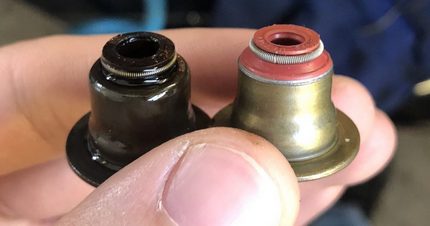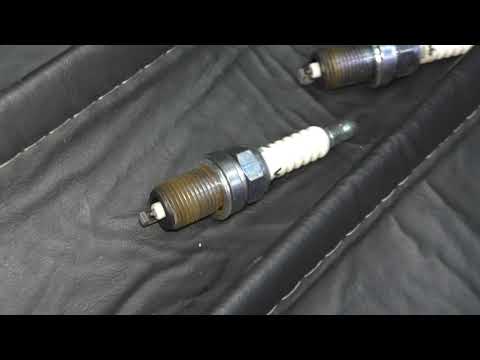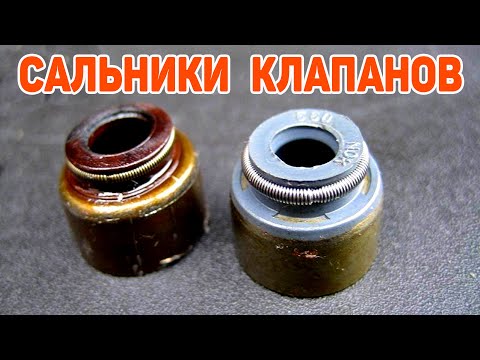
Worn valve stem seals
Content
Timing valve seals, better known as "valve seals", prevent oil from entering the cylinder head into the combustion chamber when the valves are opened. Resource these parts is approximately 100 thousand km., but with aggressive operation, the use of low-quality fuels and lubricants and after a long idle period of the internal combustion engine (more than a year), the wear of the valve stem seals occurs faster. As a result of seal wear oil enters the combustion chamber, due to which the motor loses power and is unstable, oil consumption increases significantly.
How to determine the wear of valve seals and how to eliminate it - we will tell in this article.
Signs of worn valve seals
a basic sign of wear of valve stem seals - blue smoke from exhaust pipe on startup and regassing after warming up. When opening the oil filler neck on a running internal combustion engine, smoke may come out from there, and in candle wells and on wire lugs or ignition coils it is possible traces of oil. Traces of oiling can also be found on threads and electrodes of spark plugs.
Traces of oiling on the thread of the candle
The ingress of oil into the combustion chamber leads to coking of the CPG parts, which is fraught with burnout of the valves and the occurrence of piston rings. Over time, this may lead to the need for an overhaul of the motor. Increased oil consumption is also dangerous - with untimely topping up, overheating, scoring and even jamming of the internal combustion engine are possible. Symptoms of worn valve seals are similar to signs of other problems leading to oil burn, so you first need to make sure that the problem is in the valve stem seals.
How to determine the wear of valve stem seals
All the symptoms of valve stem seal wear, the causes and diagnostic methods leading to this are summarized in the table below for convenience.
| Symptom | Causes of appearance | Aftermath | Diagnostic methods |
|---|---|---|---|
| Blue smoke coming out of the exhaust | The oil flowing from the cylinder head into the combustion chamber along the valve necks burns together with gasoline and its combustion products color the exhaust blue. | The combustion products of the oil form soot, the rings “lie down”, the valves no longer fit snugly and can burn out. If the lubrication level falls below the minimum, the internal combustion engine may fail due to oil starvation. | Start the internal combustion engine after idle for 2-3 hours or sharply squeeze the gas pedal to the floor for 2-3 seconds at idle with a warm engine. Assess the presence and color of smoke. |
| Carbon deposits on the electrodes of candles, oily thread | Excess oil from the combustion chamber is squeezed out along the threads of the candles, but the o-ring prevents it from coming out. | Sparking worsens, due to which the air-fuel mixture burns worse, the engine starts to work unstably. On injection ICEs, the ECU detects misfires and tries to fix them by changing the size of the injected fuel portion and the ignition timing. Because of this, the consumption of gasoline increases and traction is lost. | Unscrew the candles and inspect their electrodes, as well as the threads for oiling and soot. |
| Increased oil consumption | Oil freely penetrates into the combustion chamber through damaged valve seals, where it burns along with fuel. | The operation of the motor deteriorates, soot forms in the cylinders, and a critical drop in the level of lubrication can be fatal for the internal combustion engine. | Regularly check the lubricant level after reaching a certain mileage mark. Oil consumption when the valve stem seals are worn reaches 1 l / 1000 km and even more. |
| Difficulty starting a cold engine | The oil flowing from the cylinder head accumulates on the valves and pistons, “throwing” the candles. Since its ignition temperature is much higher than that of gasoline or gas, and an oiled candle produces a spark worse, it becomes difficult to ignite a mixture enriched with lubricant. | The load on the battery increases, its service life is reduced. Candles in oil also work worse, as they quickly become covered with soot. The remains of unburned oil contaminate the catalyst and lambda probes, reducing their life. | With a cold start, the number of revolutions of the starter increases until the engine starts. |
| Blue smoke coming from the oil filler neck | Exhaust gases at the moment of opening the valve through a worn stuffing box enter the cylinder head and go out through the neck. | The oil is saturated with combustion products, due to which it quickly changes its color and loses its original lubricating and protective properties. | Open the oil filler cap while the engine is running. |
How to understand: wear of valve stem seals or a problem in the rings?
Diagnosis of valve stem seal wear is not limited to visual methods. These same symptoms may indicate other problems, such as the occurrence or wear of piston rings or a non-working crankcase ventilation system. in order to distinguish signs of valve seal wear from other problems, you need to:

How to determine the wear of valve seals with an endoscope: video
- Check compression cold and hot. When the MSC is worn, the pressure in the cylinders is usually normal due to the abundant lubrication of the CPG parts. If the cold compression is normal (10–15 atm for gasoline, 15–20 or more atm for a diesel engine, depending on the degree of compression of the engine), but after a short operation (before warming up) it decreases, there may be problems with the caps. If it is low both when cold and after warming up, but rises after injecting 10–20 ml of oil into the cylinders, the problem is in the rings or cylinder development.
- Remove the breather pipe while the engine is running.. If bluish smoke comes out of the oil filler neck, you need to remove the crankcase ventilation pipe leading from the crankcase to the cylinder head (its hole on the head must be covered to prevent air leakage). If the valve seals are worn, smoke will still go out of the neck. If the problem is in the rings or cylinders, smoke will come out of the breather.
Blue smoke from the exhaust pipe at the time of starting indicates the presence of oil in the combustion chamber
- Determine at what moments smokes from the exhaust. When the valve seals are worn, blue smoke escapes from the exhaust at the time of start (because oil has accumulated in the combustion chamber) and during regassing after warming up (because when the throttle is open, the oil sucks into the cylinders). After a few regassings, the smoke may disappear. If the oil scraper rings of the piston are faulty, then it smokes constantly, and the higher the speed, the stronger the smoke.
- Examine the valve discs with an endoscope. The internal combustion engine must be allowed to cool, then unscrew the candles and inspect the valves with an endoscope through the candle wells. If the valve seals do not hold oil, then it will gradually flow down their necks, forming oil stains on the valve plates and seats. If there is a strong leak of valve stem seals, it is even possible for oil droplets to get on the piston. If the valves are dry, then the problem is in the rings.
How to fix leaking valve stem seals
If the valve seals are leaking, there are two ways to fix the problem:
- replace valve stem seals;
- use special additives.
Replacing valve stem seals is a time-consuming procedure that requires intervention in the cylinder head. On many motors, a partial disassembly of the head will suffice, but on some models it must be completely removed.
Homemade tool for removing oil seals from pliers
To replace the valve seals, you need:
- wrenches / heads and screwdrivers (numbers depend on the car model);
- valve desiccant;
- wrench for timing belt tension;
- collet cap remover, or long-nose pliers with a round grip, or powerful tweezers;
- flexible tin rod up to 1 cm in diameter and 20–30 cm long;
- mandrel tube for pressing new seals.
you will also need to buy the seals themselves, the number of which is equal to the number of valves in the internal combustion engine.
in order to independently replace the MSC, you need:

When and how to change valve stem seals: video
- Remove the spark plugs and remove the valve cover (covers on V-shaped internal combustion engines).
- Loosen the belt and remove the camshaft (shafts on V-shaped and DOHC motors).
- Remove the valve pusher (cup), hydraulic compensator, adjusting washer or other parts that block access to the "crackers".
- Dry the valve and remove the spring.
- Using a collet, long-nose pliers or tweezers, remove the old stuffing box from the valve.
- Lubricate the stem with oil and press on a new cap with a mandrel.
- Assemble the valve actuator in reverse order.
- Repeat steps 4-8 for other valves.
- Install the camshaft and align the shafts according to the marks, tighten the timing belt, complete the assembly.
Replacing valve seals at a service station will cost from 5 thousand rubles (plus the cost of new seals). In some cases, you can get rid of the leak with the help of special chemistry.
Valve Seal Leak Additives
You can stop the leakage of valve seals, if they are not damaged, but only slightly deformed, with the help of special additives for engine oil. They act on the rubber seals of the internal combustion engine, softening their material and restoring its elasticity, thereby stopping the leakage of valve stem seals.
- Liqui Moly Oil Loss Stop. The additive works as a stabilizer for the viscosity properties of engine oil, and also acts on rubber and plastic seals, restoring their elasticity. It is added to the oil at the rate of 300 ml (1 bottle) per 3-4 liters of lubricant, the effect appears after 600-800 km.
- WINDIGO (Wagner) Oil Stop. An additive for engine oil that does not change its properties and acts only on oil seals. Restores their elasticity, reduces gaps, thereby stopping oil leaks. It is added to the lubricant in a proportion of 3-5% (30-50 ml per liter).
- Hi Gear HG2231. Budget selective additive that does not affect the viscosity and lubricity of the oil, acting on rubber seals. It is poured at the rate of 1 bottle per working volume of oil, the effect is achieved after 1-2 days of driving.
Liqui Moly Oil Loss Stop
WINDIGO (Wagner) Oil Stop
Hi-Gear HG 2231
Oil additives are not a panacea, so they are not always effective. These are also capable extend the life of valve seals by 10-30%, the mileage of which is close to the estimated resource (up to 100 thousand km), temporarily “treat” the current valve stem seals and smoke from the exhaust at an early stage of the problem, but do not eliminate the running breakdown.
If the valve stem seals are completely worn out, the oil consumption is about 1 l / 1000 km, or the seals on the engine that has been standing for 10 years without movement have completely dried up - the effect, at best, will be partial. And if the problem can be minimized, you still need to prepare for replacing the valve stem seals after 10-30 thousand km.
F.A.Q.
How long do the valve stem seals go?
The pledged resource of valve stem seals is about 100 thousand km. But due to overheating, the use of low-quality oil or a violation of its change intervals, the service life is reduced, so it is often necessary to change the valve seals after 50–90 thousand km. If the machine has been idle for several years, then the valve stem seals dry out and before you start using the machine, you need to replace them.
What are the signs of broken valve stem seals?
The fact that the valve seals are worn out is usually indicated by 3 basic signs:
- bluish smoke from the exhaust and from the oil filler neck at the time of start-up until the internal combustion engine warms up and when the gas pedal is pressed hard;
- oil soot on spark plugs;
- increased oil consumption.
How to determine if rings or valve stem seals are leaking?
Certain conclusions can be drawn from the nature of the exhaust, since the internal combustion engine smokes when the valve stem seals are worn out only during start-up and regassing. With a quiet ride, there is usually no smoke. you also need to inspect the breather: the smoke from it usually indicates a problem with the CPG, or a clogged crankcase ventilation system. When the rings are worn, the smoke and the smell of burnt oil will be constant.
Can the valve stem seals be repaired?
It is possible to restore the elasticity of valve seals with the help of modern auto chemical goods. There are oil additives, such as Liqui Moly Oil Verlust Stop, which restore the properties of rubber valve stem seals and other seals and eliminate their leakage.

